市场资讯及洞察
.jpg)
摘要
IEA 最新月报显示,全球石油需求增速放缓但仍具韧性。尽管库存持续回升,但 OECD 库存整体仍低于五年均值,市场对供应中断高度敏感。OPEC、IEA、EIA 均上调非 OPEC 供应,未来可能出现“松中带紧”的供需结构。原油价格在供应宽松预期与地缘扰动之间反复震荡,波动率下降但敏感度上升。油市表现也可能通过风险偏好外溢至能源板块、商品货币及相关市场。
一、全球原油供需前景:IEA 月报核心要点
国际能源署(IEA)最新原油月报显示,全球石油需求虽较去年降温,但整体依旧保持韧性 [1]。先进经济体消费表现好于预期,有效抵消部分新兴市场的疲弱需求。IEA 预计 2025–2026 年全球石油需求将保持温和增长。然而在供应方面,如果 OPEC+ 维持当前产量政策且需求不出现明显下滑,全球石油市场未来数个季度可能重新进入“边际紧平衡”状态。IEA 同时指出,高油价、全球经济放缓、电动车渗透等因素正在逐步压制需求增速,使油市呈现出“短期紧平衡、长期温和宽松”的结构。
二、多机构观点对比:OPEC、EIA 与 OECD 数据
三大机构对于未来市场平衡的看法存在显著差异,这主要源于对非 OPEC+ 供应增长和需求韧性的不同假设。总体来看,市场普遍认同未来供应将更加充裕,但对于过剩的规模和时间点存在分歧。

图 3:三大机构对 2025-2026 年需求与供应增长的预测对比,显示供应增长普遍超过需求增长,预示市场将进入供应过剩周期。
OPEC 的观点相对乐观。OPEC 预计 2025 年全球石油需求将增长约 130 万桶/日,2026 年略高至 140 万桶/日 [2]。与此同时,OPEC 在最新报告中连续上调非 OPEC 供给预期,并首次将 2026 年市场从“短缺”调整为“小幅过剩”,反映其判断未来供应增长可能快于需求。
EIA 的判断更偏向供应充裕。EIA 上调了美国页岩油产量预测,指出 2025 年美国原油产量将创历史新高。同时,全球供应预期被上调至日均 1.06 亿桶,高于全球消费的 1.041 亿桶,意味着未来库存可能持续累积 [3]。EIA 预期 2025–2026 年库存增加将对油价形成中期压力。
OECD 库存虽然持续回升,但仍低于五年均值。IEA 数据显示,今年全球观测库存前八个月净增约 2 亿桶,但 OECD 商业库存仍比五年均值低约 6700 万桶。整体来看,库存虽然恢复,但仍处历史偏低区间,使油市对供应中断的敏感度依旧很高。
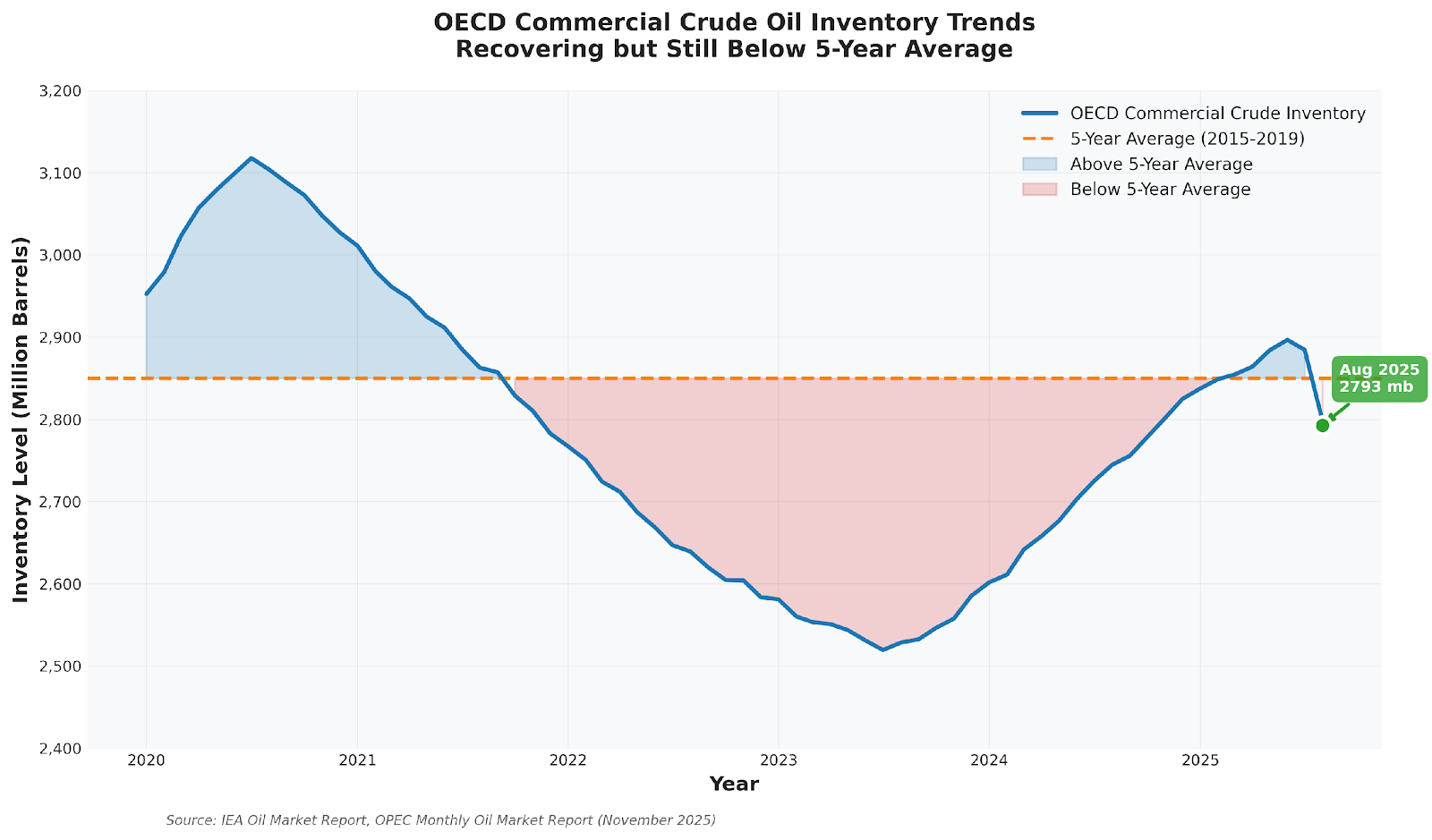
图 1:OECD 商业原油库存近 5 年对比最新水平,显示库存虽有回升但仍低于五年均值。
三、原油价格走势:WTI 与 Brent 如何消化预期
2023 年下半年,布伦特因供应紧张和地缘冲突预期一度突破每桶 90 美元。然而进入 2024–2025 年,随着供应回升和库存恢复,油价整体震荡下移。近期价格承压主要来自供应过剩预期强化以及美国库存意外上升。
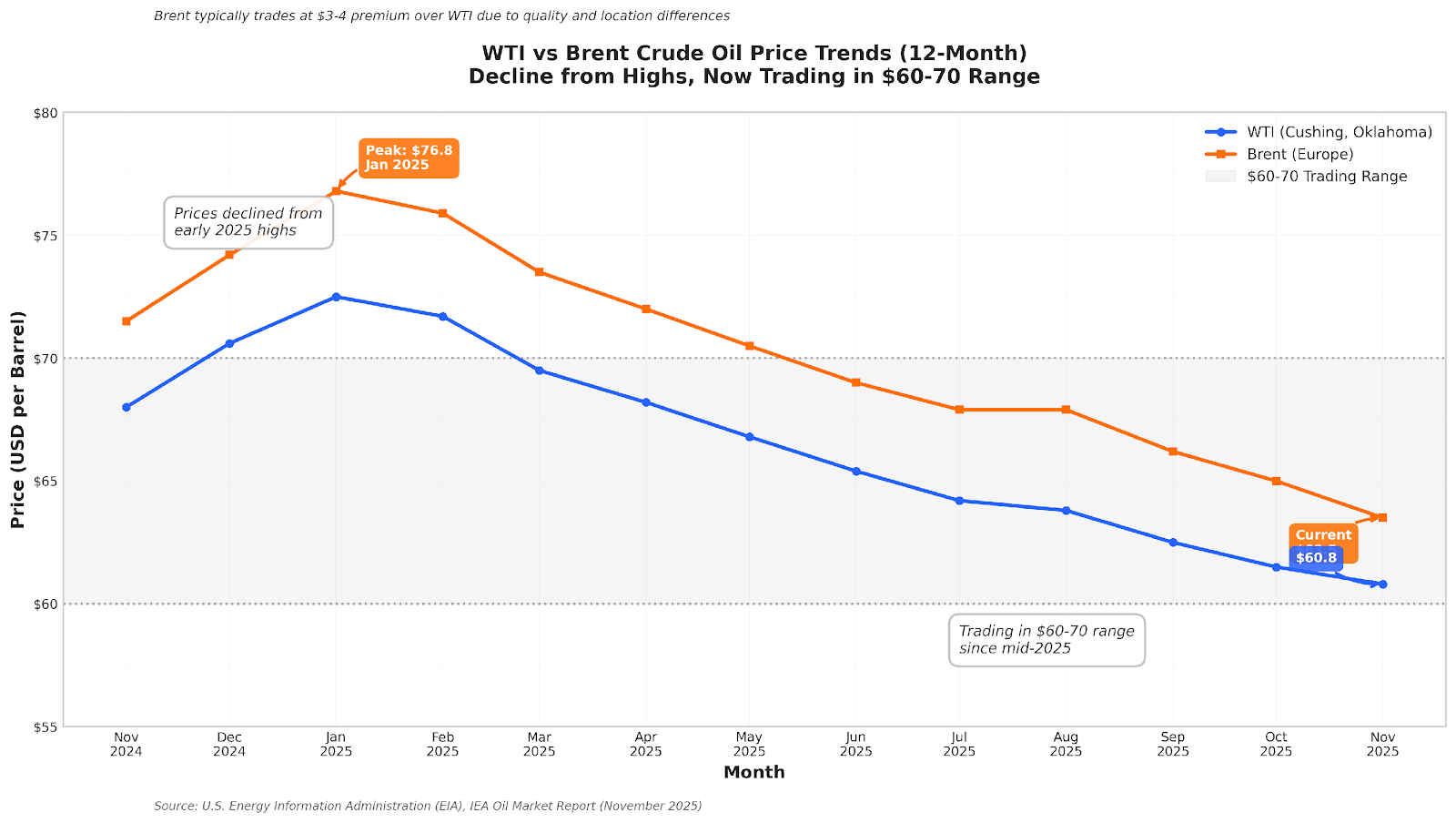
图 2:WTI 与 Brent 价格从 2025 年初的高位回落,近期在 60–70 美元区间震荡。
尽管地缘事件偶尔推升价格,但反弹难以持续,因为供应宽松的结构性预期迅速重新主导市场。WTI 与 Brent 的期限结构一度出现小幅 Contango,显示短期供应充裕压制近端价格,而远月因长期需求预期而保持相对坚挺。整体来看,油市呈现低波动、弱趋势但对消息高度敏感的特征。
四、驱动油市的关键变量:地缘政治与供应端不确定性
运输通道风险仍是油市最大的潜在冲击点之一。全球三分之一海运原油经过霍尔木兹海峡,一旦受阻便可能引发油价剧烈波动。衍生品定价显示断供概率虽低,但属于典型的“低概率、高冲击”事件。
OPEC+ 的政策滞后性也带来结构性波动。减产会压低库存、推高价格,但高油价又刺激非 OPEC 增产,使市场重新宽松。美国页岩油增速放缓进一步加剧供应端的不确定性,削弱其作为“摇摆产能”的角色。此外,俄罗斯、伊朗等国因制裁和冲突导致出口波动,更加剧油市敏感性。
五、油市变化的外溢影响
能源板块通常与油价同方向变动,但反应速度较油价更平缓。油价对风险偏好的溢出效应也容易影响澳元等商品货币。大宗商品价格上行往往提升商品出口国的贸易条件与风险情绪,而价格下跌则可能压制相关货币表现。
六、原油市场风险提示
- 数据发布风险: EIA 每周库存、IEA 与 OPEC 月报可能导致短线波动。
- 地缘政治风险: 产油区冲突、海运通道中断、制裁变化均可能影响供需平衡。
- 宏观风险: 利率政策、美元走势及全球经济增速变化都可能改变需求前景。
结语
IEA 最新展望显示,全球油市进入“边际紧平衡”阶段:库存修复但仍偏低,供应端不确定性大于需求端。在这种结构性环境下,油市会对政策、地缘事件与供给变化表现出高度敏感。理解供需框架、关注库存趋势与识别关键风险,将是未来判断油市走向的关键。
参考资料
[1] IEA (International Energy Agency). (2025, October). Oil Market Report - October 2025. https://www.iea.org/reports/oil-market-report-october-2025
[2] OPEC (Organization of the Petroleum Exporting Countries). (2025, November). Monthly Oil Market Report. https://publications.opec.org/momr
[3] EIA (U.S. Energy Information Administration). (2025, November). Short-Term Energy Outlook. https://www.eia.gov/outlooks/steo/


The primary reason for the drop in price is the economic slowdown that has become prevalent in the global market. As fears of a recession continue to grow, the price of Oil has continued to drop. To make matters worse, the G7 have set a $60 per barrel price cap.
This price cap was created to restrict Russia’s ability generate revenue from its oil exports by making the G7 Oil more competitive. From a fundamental perspective this may push the price lower towards the price cap. On the contrary, Russia has threatened to reduce its supply which would force the price to rise.
The situation remains volatile and subject to geopolitical shifts. From a technical perspective the price of Brent Oil is now at its lowest level for the year and below the levels prior to the Russia and Ukraine war. The price is also now well below the 200 day and 50 day moving averages and is dropping at a fast rate.
The price is currently resting on the $76 support levels with the next point of support at $70. If this level fails, as stated above the logical support is $60 based on the price cap. It is also interesting to note that the price of Brent is at its lowest RSI level since December 2021.
In recent times every time since 2022, it has been this low the price has bounced in the short term. On the weekly chart, the price is very similar although the RSI has more room to go before it hits the oversold level. This indicates that there may be more of a sell off before a bounce occurs.
With global volatility still high and fears of a recession continuing to grow, the price of oil may continue to fall.


AutoZone Inc. (NYSE: AZO) reported the latest financial results for its first quarter of fiscal 2022 (12 weeks) that ended on November 19, 2022. The largest US retailer of aftermarket automotive parts reported revenue of $3.985 billion (up by 8.6% year-over-year) vs. $3.865 billion expected. The company reported EPS of $27.45 per share for the quarter (an increase of 6.9% year-over-year) vs. $25.258 per share expected.
AutoZone opened 35 new stores during the quarter. ''I would again like to thank and congratulate our AutoZoners across the Company for their ongoing commitment to deliver great results and exceptional customer service. Their efforts allowed us to deliver solid same store sales results on top of last year’s very strong 13.6%. While our Commercial sales growth accelerated 15%, our retail sales also grew impressively from a year ago.
We continue to believe our initiatives to grow our business position us well for the remainder of our fiscal year,'' Bill Rhodes, Chairman, President and CEO of AutoZone said in a press release after the announcement of the latest results. As of November 19, 2022, the company had 6,978 stores within the United States (6,196), Mexico (706) and Brazil (76). The stock was down by around 5% on Tuesday at $2383.48 a share.
Stock performance 1 month: -3.77% 3 months: +12.70% Year-to-date: +14.56% 1 year: +18.68% AutoZone price targets Wells Fargo: $2850 Truist Securities: $2533 Raymond James: $2500 Argus Research: $2330 Jefferies: $2450 JP Morgan: $2660 Wedbush: $2350 Citigroup: $2520 UBS: $2260 Goldman Sachs: $2296 AutoZone is the 358 th largest company in the world with a market cap of $45.54 billion. You can trade AutoZone Inc. (NYSE: AZO) and many other stocks from the NYSE, NASDAQ, HKEX, ASX, LSE and DE with GO Markets as a Share CFD. Sources: AutoZone Inc., TradingView, MarketWatch, MetaTrader 5, Benzinga, CompaniesMarketCap


热门话题
上周我们的系列一文章结尾中提到,道氏理论只是提出“一个趋势会一直持续直到转变”,但是没有给出转变的定义和识别方法。但是他的后人华尔街传奇维克多斯波朗迪,在道氏的基础上提出了识别趋势的著名123法则,收录在作者的《专业投机原理》一书中。
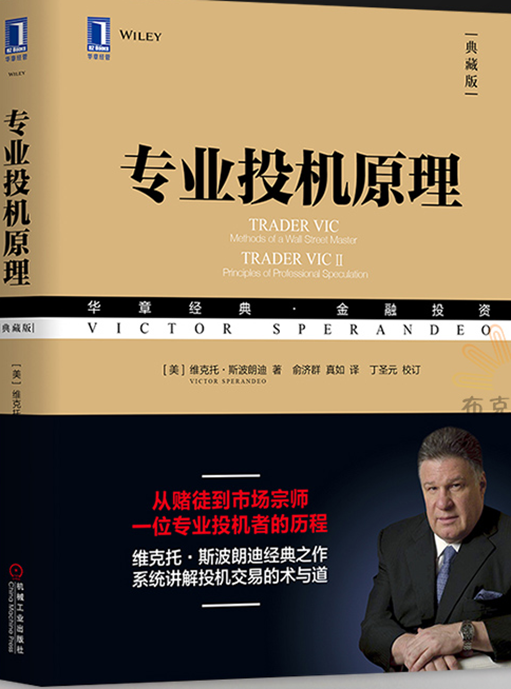
123法则认为趋势转变可以有三个标准,分别是1.趋势线被突破;2.上升趋势不再创新高,或下降趋势不再创新低(即只发生试探前期高低点行为);3.上升趋势中,价格向下穿越先前的短期回档低点或下降趋势中,价格向上突破前期反弹高点。下图就是这三段的拆解。
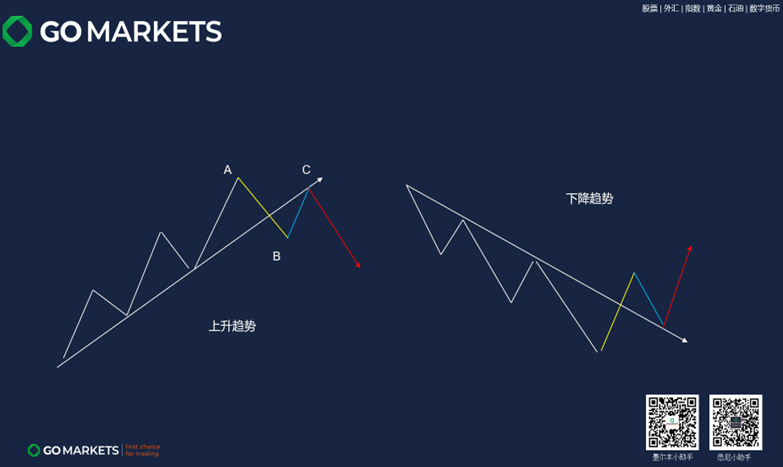
左图黄线代表在一段上升趋势价格从最高点A点中首次下降突破趋势线,第一个条件成立,并在B点形成一个回档低点。然后价格沿着蓝线回抽在趋势线遇到压力形成次高点C点,即不再创新高,第二个条件也成立了。最后价格在红线继续下跌破了B点,第三个条件成立,这样就标志着趋势完成了反转。从形态学的角度,你也可以理解在行情的顶部形成一个M头或一个N字,高点在变低,低点也开始变低,后续大概率就会走一个下降趋势或通道。反之,下降趋势中就是换个方向表达价格转变。下图是今年9月美元指数见顶后开启下行的4小时图实例,运用123法则非常标准的逃顶策略。
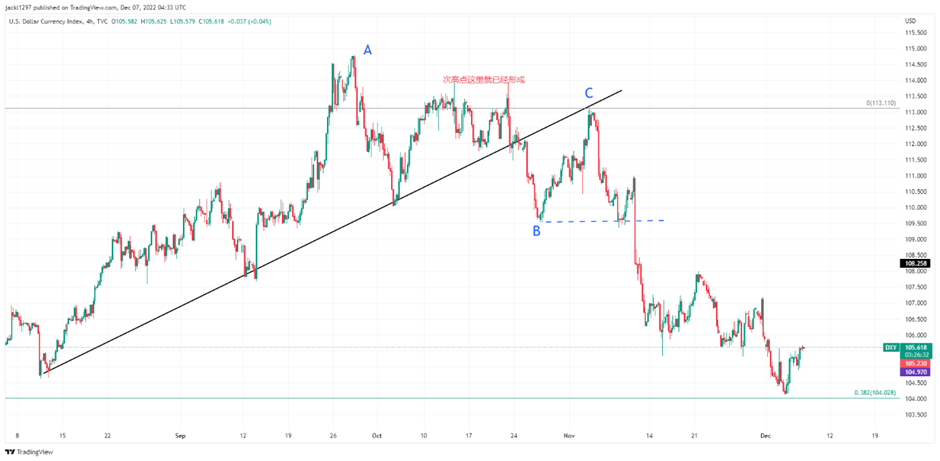
但是正如道氏理论被人诟病的地方,这种方法的滞后性还是比较明显的(任何交易方法都是有缺点的,没有完美的),等到上述反转点被确认,行情从最高点已经下跌了蛮长一段了。更不用说本质上操作这种反转行情,是属于逆势交易。正如系列一文章所说,道氏定义了三分之二幅度以内同时未超过三个月的回调都是属于次要趋势,所以行情是随时有可能“反转”后又重回主趋势的。这种情况下,交易的盈亏比就不是很理想。如下面的欧美日图所示,假设后市欧美多头失利止步于1.0600,那运用这个法则能赚取的利润仅仅大概在280个基点,2.67%左右,而你等待这个反转机会却花了足足9个月。
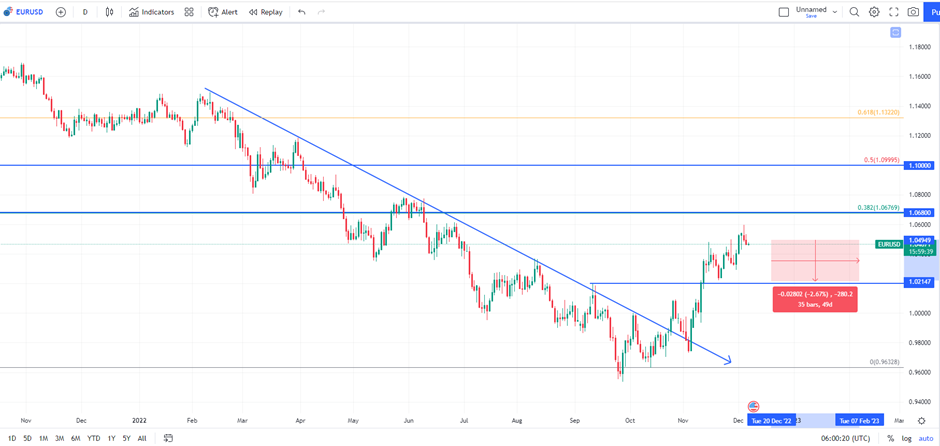
所以最好的解决方法就是顺势而为(通常交易里最为重要的一项),抓住次要趋势的转变,保持和主趋势的一致性。看下目前的标普500期货图走势,技术面是有这个机会的。日线上看,近期标普未能打破今年熊市下降趋势线和4120-4150区间水平位阻力位,昨日收盘价3941更跌破了10月中旬以来的上行通道,几个利空信号已经出来。基本面看,估计市场已经完全消化了12月中旬美联储加息50个基点的利好,同时强劲的经济数据也有理由让加息75个基点的可能性提高。一般临近圣诞假期将导致交易量萎缩,交易者或许更倾向于套现进入新年。因此笔者的偏见是,伴随着美元反弹,标普500当前应该是重新开启下跌主趋势的时候了。长期目标自然是看到前低3500,想象空间还是够的。但是最后行情如何演绎,还是要看经济层面的问题和市场的反馈。
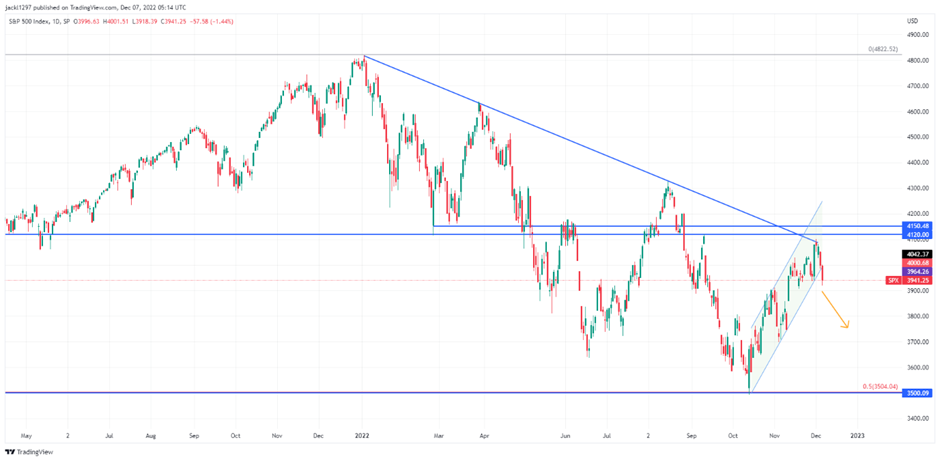
最后不得不提的是,以道氏理论为首的技术分析,普遍适用于交易量大的金融市场,但是对于好操控的小盘股则会失效。另外一个是理论和方法不复杂,但是学习完以后如何灵活应用、配合基本面分析和消息面事件、建立指标与交易系统,则是一项长期的任务。免责声明:GO Markets分析师或外部发言人提供的信息基于其独立分析或个人经验。所表达的观点或交易风格仅代表其个人;并不代表GO Markets的观点或立场。联系方式:墨尔本 03 8658 0603悉尼 02 9188 0418中国地区(中文) 400 120 8537中国地区(英文) +248 4 671 903作者:Jack Lin | GO Markets 新锐分析师


The major American Indices have begun the last month of the year with in an extremely bearish state as recessionary fears rise to the surface again. With the positive sentiment relating to a potential pivot from the federal reserve seemingly disappearing, thoughts of a hard landing have become increasingly prominent. Even with an expected slowdown in interest rate hikes many analysts fear that it won’t be enough to pull the economy out of a recession or even a soft landing.
Technical Analysis The S&P500 has seen a major pivot off its long term down trend. The index has fallen by nearly 4.5% too begin the month and is showing a very similar price action to the three last downward moves. In addition, the 200-day moving average has once again acted as significant resistance for the index as it tried to reverse out of the down trend.
The RSI has also seen a break of its upward trend adding to the confirmation of the overall breakdown as buying has become exhausted. Moving forward, there is likely to be some potential support in the short term near 3900. However, if this support fails then the secondary target or support levels is a 3800 and then 3504 after that.
Therefore, there is potentially a large swing to the downside if the sentiment becomes worse and selling continues. The NASDAQ in particular has been following a similar trend to the S&P500 whilst the Dow Jones Index has been the more resilient of the US Indices. However, both of them have also felt the selling pressure from the S&P500 and the negative sentiment trickle down.
The NASDAQ in particular has faced a difficult time as the growth and technology sectors are smashed with the recessionary talk and inflationary pressures. With the end of the year fast approaching, the prospect of a Santa rally looks less promising with the sentiment in the market at the moment.


How to use Arbitrage trading to increase profits Professionals in finance like to use hard to read and complicated language to make what they do much harder and more complicated than it sounds. However, when it comes to arbitrage, it is actually a relatively simple concept that can be used in trading, to develop an accurate system that can be used in various markets. The Law of One Price In order to understand Arbitrage trading, a trader needs to understand the law of one price.
It states that the same goods sold in different markets in conditions, free of competition and expressed in the same currency, must be sold at the same price. Although this is an economic theory, the principles follow into financial markets. This means that in an efficient market, prices for the same asset cannot be different.
In practice, this is not always the case or rather it is not always the case straight away and his is where arbitrage opportunities exist as the market tries to move the prices into one. What is an Arbitrage? An arbitrage is when the law of one price has not yet been realized.
Essentially, the market is in the process of converging the prices. The best example is that of dual listed companies. These are companies who have shares listed on multiple exchanges.
Initially the price may be different due to exchange rates, different number of shares on issue. However, the relative value for each share must be the same. Usually, they are larger companies or multinational companies.
For instance, BHP is listed on both the ASX and the London Stock Exchange. The strategy can involve selling the shares on the exchange where it is more expensive and buying them back on the cheaper exchange or the alternative and profiting the difference. Other arbitrage opportunities can exist in companies that are primarily traded on an exchange but also have an over the counter, (OTC) listing.
These OTC listings are often much more illiquid allowing for more arbitrage opportunities Additionally, the primary market will usually be the lead pricing target, whilst the OTC or secondary market will attempt to move towards that price. Merged Arbitrage This strategy involved targeting companies that are in the process of being taken over or bought out. The acquirer will need to put an offer per share in order for a take-over to occur.
This gives the market a value for the shares. Generally speaking, the price will have to move towards the offer, especially if it is accepted. In a recent example, company Tassal formally TGR.AX, announced it was being bought out by a private equity firm.
There were previous offers made at $4.67, $4.80 and $4.85 per share before the final offer came at $5.25 a share. It can be seen from the price chart that the share price did not reach $5.25 immediately. The interesting thing to note here is that even though the final and accepted offer came in at $5.25 on the day of the announcement the price only reached $5.12 still $0.13 short of the offer.
This represented an arbitrage opportunity of $0.13 for savvy traders and investors. Although the actual % gain was not very high, the relative certainty of the price target made this trade a potential big winner. Opportunities like this are not always perfect and deals may not always follow through, but a skilled trader can develop a very strong system around this premise.
Overall, arbitrage trading may seem difficult but in reality, the theory is relatively straight forward. Finding mispricing within the market and capitalising on them can take some practice but they can also offer longer and shorter terms edges when the market is not providing other sufficient trading opportunities.


As a new trader, riding the emotional ups and downs can be a very difficult task. It is human nature to feel the pain of a losing trade. The losing often outweighs the positive feeling of any winning trade.
Dealing with the emotion of trading can be an incredibly difficult task. It can cause even the best system to fail. A trading journal especially early on in a trading journey can provide important feedback and information about the effectiveness of an edge.
The reality is that early on profit and loss can be terrible measure of an individual’s trading ability which is why a journal is so essential. There are many different formats and styles of journals that can be used. Some like to base their journal around a calendar.
Others like to pick out their best and worst trade each day and analyse them intensely. In the end, it doesn’t matter what style is chosen if a consistent structure is followed. Both quantitative and qualitative measures that ca be used to measure performance.
What to include in your journal? Below is a breakdown of elements that can be analysed in the trading journal. Initial trade idea – This is the overall basis of the trade, it can be related to a technical pattern, fundamental factor such as a news or a mix of both.
Some traders call this the trade hypothesis or thesis. In its most simple form, it is the very reason a trader enters into a trade. When journaling, it is important to evaluate the strength of the idea, whether it was correct and why or why not the trade was validated or invalidated.
It is also worth noting if the idea is a common one, such as news catalysts, repeating technical patterns. This can also be elevated by understanding how different trade ideas work together to create stronger overall trade ideas. Entry – Breaking down the key elements of the trade are important aspects to a journal.
More specifically outlining whether an entry was ideal, correct and managed well. Was the entry chased or was patience shown to achieve a more ideal entry. The entry is also a part of a trade with heightened emotion.
Therefore, journaling how emotions were managed and ways to improve emotional management is an important aspect of reviewing the entry. Exit – It goes without saying that the exit is the reciprocal of the entry and just as important. Analysing whether the exit was correct at both the time and in hindsight is an important step.
By continuously analysing both entries and exits, a trader will likely see an improvement in this aspect of their trading. In addition, they will potentially remove external factors such as emotion and noise from other influences such as twitter. Sizing – Sizing is an extremely tricky area of trading to master and there are many different theories on what sizing tactic is the best for each trade.
Some traders like to increase size depending on how strong a trade set up is whilst other like to have more consistent sizing strategies regardless of the strength of a trade. When reviewing it is important to make note of whether the sizing strategy worked. Trading with too much size can affect the active management of a trade as a trader can lose sight of the trade at hand and become too concerned about the potential outsizes loss.
Trade management – Whilst all the above can all constitute some level of trade management reviewing, analysing the whole management of the trade is vital. This can include the effectiveness in taking profits or losses and how the trader has dealt with their emotions. Management of fear and greed are the two most common emotions that a trader feels.
Grading – Having some quantitative measure even though it is subjective can help classify many trades over a long period of time. Using either letters or a number ranking can be just one method. This allows for a trader to identify their best performing trades and where the strongest edge is.
This list should not be seen as exhaustive, and traders can tinker and adjust to suit their own trading strategy. Reviewing the journal. It is important to review the journal at the end of a set time whether it be weekly or monthly to see if common mistakes are occurring or a theme is emerging.
If the same mistake keeps occurring, it may act as point of emphasis for future journaling or improvement. Ultimately, using a journal can accelerate the learning curve drastically especially for new traders.

